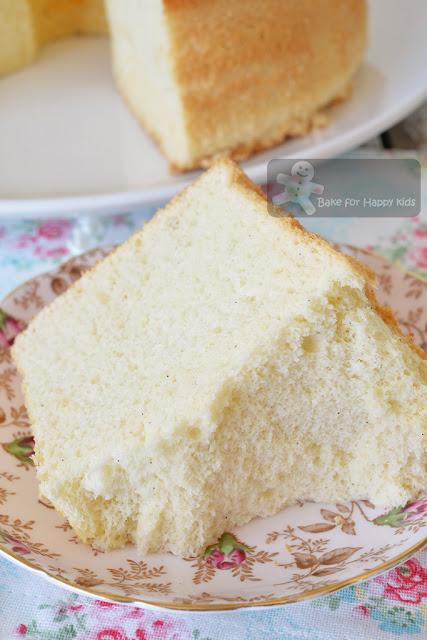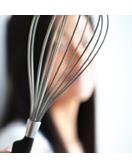After deriving these ultra soft chiffon cakes at here (banana chiffon cake), here (honey chiffon cake), here (cranberry yogurt chiffon cake) and here (cocoa chocolate chiffon cake), I have been going through a tough journey just to bake a basic milk chiffon cake that is ultra soft enough *Ahem* to pass my very strict cake standard!!!
You have to believe me... I have gone SO mad, crazy and all out just to optimise an ultra soft milk chiffon cake recipe!
And finally, I did it!!!
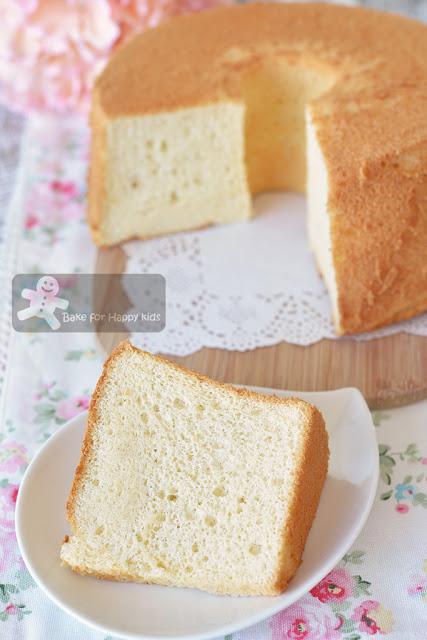
Ultra Soft Milk Chiffon Cake
As seen at here (banana chiffon cake), here (honey chiffon cake), here (cranberry yogurt chiffon cake) and here (cocoa chocolate chiffon cake), I have this ultra soft chiffon cake belief that the chiffon cakes that are baked cream of tartar, baking powder or any cake raising agents are actually the BEST being the most moist, tender and cottony soft!!!
To me, although the addition of cream of tartar and baking powder will make chiffon cakes looking tall, fluffy, impressive, structurally stable and easier to bake and handle, these cake-rising ingredients tend to make the cakes structurally stiffer and kill their ultimate softness! Agree? You probably think I'm a cake cuckoo... LOL!
Then, how do I derive my ultra soft chiffon cake recipes?
I've been totally obsessed with chiffon cake recipes and do have a few theories and guidelines to create my ultra soft chiffon cake recipes. Along with my theories, I did lots of trial-and-error baking to fine-tune my creations.
Many readers have asked me if they can substitute this with that or that with this to make the chiffon cake that they want. Hmmm... Not really! Some ingredients can be very different causing some modifications to be not so straightforward and easy!
So what are my theories? Here you go... but you know what? I might be wrong sometimes!!! LOL! To me, every recipe that I created HAS to be well tested and tasted before I can safely say... Yes! This is the approved cake! And I hope that you can understand this will take a lot of my time!!!
Theory one: Use more egg whites than yolks
Due to the absence of cake-rising ingredients, I prefer to use more egg whites than yolks to maximise the raising of the cake but sometimes, adding too much egg whites can toughen some cake texture too.
Theory two: Use maximum liquid ingredient and minimal flour
More liquid ingredients and less flour added in a cake means that the cake will be moister. Agree? Yes and no because the chiffon cake with excessive amount of liquid might turn out to be unstable with extremely large bubbles or go the opposite way being not risen well resulting the cake to be dense or even tougher than usual.
Theory three: Use cake flour or add cornflour into all purpose flour or cake flour
This is baking 101! Using cake flour or adding cornflour will reduce the gluten content of the cake making it more tender and softer in texture.
More egg whites. More liquid. Less yolks. Less flour. Less gluten. You can imagine that the chiffon cakes that are made with the extremes of these theories will make the cakes very structurally unstable resulting them to rise well to an extended height but will shrink or even collapse after cooling.
Hence, I'm after a cut off point to apply these theories, hoping to derive a chiffon cake with the maximal egg whites and liquid used, plus the minimal yolks, flour and gluten required.
And of course, different ingredients with different properties used to bake the cake means that there will be different cut points in different recipes... something like solving a complicated maths equation. Hmmm...
So, for this cake...
First, I tried to incorporate 125g milk with 90g yolks and 240g egg whites into one 20 cm chiffon cake and the cake was so unstable that it broke apart when it was removed from the cake pan. Bummer!
Then, I reduced 125g milk to 100g and baked it with 90g yolks and 240g egg whites but the holes in the cake are way too big for my liking.
Next, after I increased the amount of egg yolks added from 90g to 110g and increase the amount of cake flour added from 120g to 135g, I began to see some promising result...
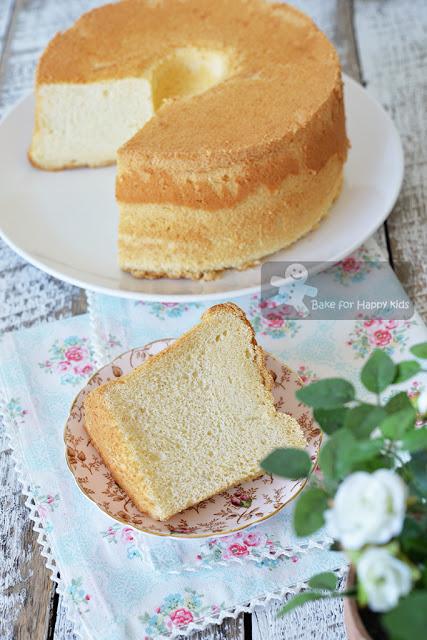
Yay!!!
This milk chiffon cake is awesome when it is baked with equal number of egg yolk and whites.
Gosh! See the cake! It looks so soft and beautiful!
Being extra fussy, I still think this chiffon cake recipe needs a little more fine-tuning as I reckon that the cake has been over-loaded in one 20cm chiffon pan. It was rising a little too rapidly and shrank a little too much. And so I reduced the recipe proportionally and baked this proportionally perfect-looking cake!
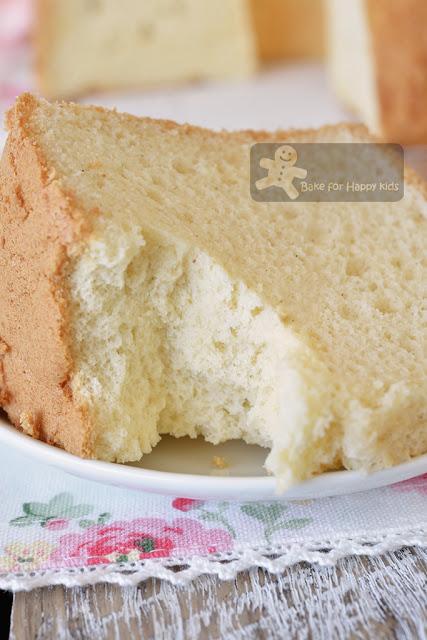
FINALLY!!! I have baked a milk chiffon cake that is so moist and cottony!
Any baking tips? As always, I do.
1) Being part of my obsession of creating the best chiffon cakes, I have discovered a peculiar way to beat my egg white mixture. Using an electric mixer with a whisk attachment, first is to beat egg whites in the lowest speed for at least 10 mins to stabilise the mixture. Then, increase beating speed to next higher speed and while beating, add sugar gradually. After all of the sugar has been added, increase beating speed to the next higher speed and continue to beat until stiff peaks form and the meringue should be smooth with very tiny bubbles. And I reckon this way of beating egg whites for chiffon cake is always working very well for me all the time!!! So remember... Never beat the egg whites with too high speed and never over-beat the egg white mixture!!!
Is there any other way to beat meringue as perfectly as my peculiar method? Absolutely! Some experienced bakers suggest that beating egg white mixture at its lowest speed for 1-2 mins after it form stiff peaks, believing that the low speed mixing will help to stabilise the meringue further and reduce large bubbles from forming. Either method will work and the choice of which one to use is totally up to you :)
2) You need at least 100g sugar to beat the egg white mixture into its best form. Please do not reduce this amount of sugar added.
3) With the maximal amount of milk added, this cake will rise rapidly during baking and will shrink a lot more after cooling. For this reason, I prefer to bake the cake in a slightly lower oven temperature at 160°C and baked it a little longer for at least 50 mins. Having said that, different ovens can be different and I know that my current Ariston oven is typically warmer than some ovens. Thus, if you think that your oven is not strongly heated like mine, you might want to bake yours at 170°C which is has always been the standard temperature to bake all chiffon cakes.
4) Like all ultra soft chiffon cakes, this very fragile and cottony soft and moist chiffon cake needs to be handled with tender loving care! Please do not unmould the cake by pressing it!!! To unmould, please use a blunt thin plastic spatula or knife to run along the cake's edges and gently push the cake out from the pan. Plus, please use a serrated knife to slice the cake.
5) This recipe makes one tall and perfect 8-inch (20 cm) chiffon cake. So, please do not ask me to calculate the amount of ingredients required to bake your chiffon cake in different sizes. To do so, you can either I) prepare the same amount of batter and bake a smaller cake using your larger pan or II) prepare the same amount of batter and use partial the amount to bake a smaller cake cake using your smaller pan or III) buy a 20cm chiffon cake pan!!! :)
6) Last but not least, please use the exact weight of the ingredients and make sure that all ingredients are at room temperature.
Gosh! At this point, I think it is enough for you from me... Too much blah blah blah!!! LOL! Told ya that I have gone SO crazy baking these chiffon cakes.
So, here's a quick video showing how I baked this ultra soft milk chiffon cake.
Like this ultra soft chiffon cake and want to bake more? I promise I will have many newly-derived ultra soft chiffon cake recipes to share in the near future and so please stay tune! To get the latest updates, you can follow me at either my Facebook at here or here or my Instagram @zoebakeforhappykids.
Here's the recipe.
IMPORTANT: Please use the exact weight and make sure that all ingredients are at room temperature.
Makes one tall and perfect 8-inch (20 cm) chiffon cakeFor the egg yolk mixture:
100g egg yolk (about 6)
50g neutral tasting vegetable oil
100g milk
1 tsp vanilla paste or 2 tsp vanilla extract, optional
120g cake flour with 8% protein
1/4 tsp salt
For the egg white mixture:
210g egg whites (about 6)
100g caster sugar
Preheat oven to 160°C/320ºF.
For the egg yolk mixture:
Using a hand whisk, whisk egg yolks and oil in a large mixing bowl until mixture is combined and turns slightly pale. Then, whisk in milk and vanilla until combined. Sift in flour and salt and whisk gently until the batter is smooth and combined.
For the egg white mixture:
Using an electric mixer with a whisk attachment, beat egg whites in the lowest speed for at least 10 mins to stabilise the mixture. Increase beating speed to the next higher speed. While beating, add sugar gradually. Increase beating speed to another higher speed and continue to beat until stiff peaks form. The meringue should be very smooth with tiny bubbles. Do not over-beat the mixture.
Using a hand whisk or a spatula, gently fold in the egg whites to the egg yolks mixture in 3-4 batches. It is ok to mix the 1st batch of egg white more vigorously into the egg yolk mixture but the subsequent portions must be folded in very gently. Make sure that most of the white is not visible after folding.
Pour batter into an un-greased 20 cm chiffon tube pan. Give the pan a gentle tap and use a skewer to draw a zigzag on the batter surface to remove any large air bubbles. Bake at 160°C for 55 mins or until it is thoroughly baked. IMPORTANT: This cake has to be baked for at least 50 mins in total.
After baking, drop the cake from a 20-30 cm height immediately onto your tabletop to minimise shrinkage. Then, invert the cake immediately to cool on a wire rack. Allow the cake to cool completely in the pan before removing it from the pan. Important: Do not unmould the cake by pressing it! To unmould, please use a blunt thin plastic spatula or knife to run along the cake's edges and gently push the cake out from the pan.The cake is fragile and so it is easier to slice with a serrated knife. Enjoy!
Store any uneaten in an airtight container at room temperature for up to 3 days.Happy BakingPlease support me and like me at Facebook...
